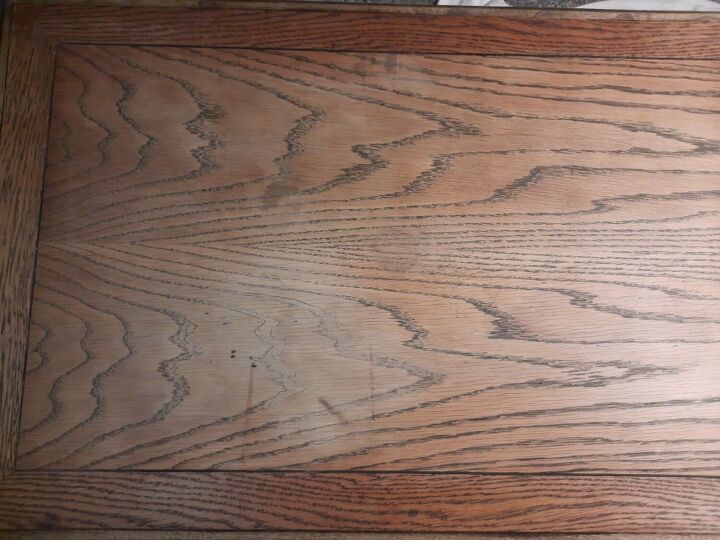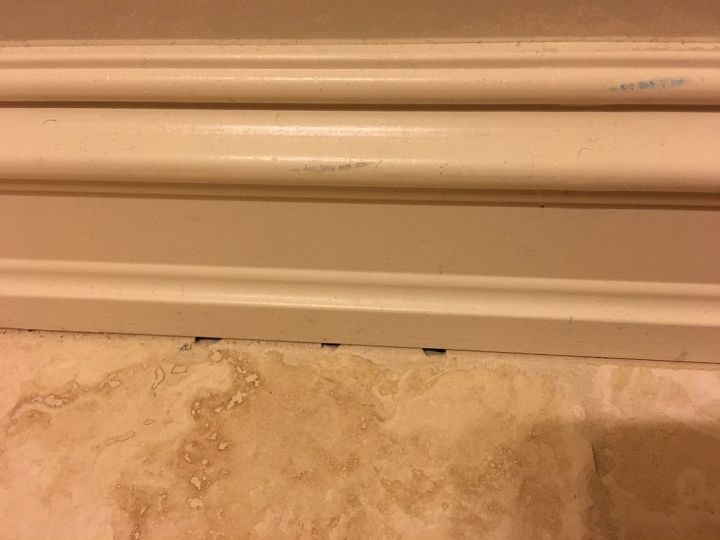There were some burnt marks where you can see the color of the table is lighter.
I mistakenly started to refinish my Lane table, how do I correct it?

I bought a table at a flea market for 25 bucks I thought it was nice so I bought it so that I could refinish it. After some research and decoding the serial numbers on the bottom I figured out that I pretty well sought-after table and I started to refinish the top and noticed that the wood grain was starting to fade off. Which only lead me to think that it would have had to have been a veneer on the top layer. Does Lane put veneer on their tables? I have only started the top of the table as far as refinishing it but after I seen this website I've learned that that that's not what I was supposed to do. So my second question would be how do I correct, as much as possible, what I've already done?
This is the other side where there were additional burn marks but larger. And I think an ink stain, if you look real closely there are little black dots that are well within the grain.
This is the length of the entire table from an aerial view
This is the logo on the bottom side of the top of the table which from what I understand the serial number means it was made on October 14th 1967? And I have scoured the internet and I cannot find another table with the same style number as mine. So I will be more than happy to know about if it's a rare table or not.
Side paneling on the long dimension of the table
Related Discussions
How to get rid of mice?
We seem to have some unwelcome Mickeys and Minnies in our house. What is the best way to get rid of them?
How to remove popcorn ceiling with asbestos?
I want to remove my popcorn ceiling, but it has asbestos in it. How do I go about this safely?
How to caulk baseboard gaps?
How do I fill gaps at baseboard, should I caulk? If so, does anyone know how to caulk baseboards?
How to fix squeaky hardwood floors?
How do I fix squeaky hardwood floors?
How should I refinish our concrete table top?
I've attached pictures to show how the top is flaking off. Thought about using steel wool to remove the finish, but don't know how to apply the stain. Looking for ad... See more










Hi Nyalic, I would contact Lane directly and ask them - https://www.lanefurniture.com/page/contact-us. They'll be able to give you the best advice possible.
most companies use veneer on furniture unless it is solid wood- here is info to help you
https://www.hunker.com/13404207/how-to-refinish-a-veneer-table-top
here is info on veneer vs. wood furniture and how to identify
https://www.laurelcrown.com/how-to-tell-the-difference-between-solid-wood-and-veneer#:~:text=If%20the%20underside%20of%20the,meaning%20they%20won't%20match.
Most likely, you used the wrong sandpaper. It also appears it was not in the direction of the grain. You could try rubbing a walnut on the area to try and restore it. Whenever you sand, it will get into the integrity of the wood. Normally, I use a stripper to remove the varnish or sealant. Then I "sand" with fine steel wool rather than sandpaper. I only use sandpaper when there is an imperfection that needs to be addressed. Then I wipe down with denatured alcohol to clean. Sometimes I use TSP to clean if I'm going to paint. Then you would be able to stain if you like or go directly to putting a finish. I would probably do 2-3 coats of polyurethane. In between coats, use the fine steel wool again to insure adhering along with wiping the residue away with alcohol.
Lane as many other companies likely use veneers on their pieces. You could complete your project with a light sanding and stain of your choice or you might consider painting the table.
Similar to yours
https://mrsnicholsonhome.com/2016/08/02/1960s-vintage-lane-furniture/
On the underside of the piece you should also find a serial number. This is very helpful as you can determine the production date by reading the serial number backwards. For example, 063270 would be 07/23/60. Without a serial number, Lane cannot determine a date of production Your piece may also contain an extra digit – this tells you the plant location.
If this info is correct, Then it seems that your serial number, 2764110, should indicate a production date of OCT 14, 1967 at plant #2.
You got a reasonable deal. You might see it a bit higher in some shops or online.
It is not a high dollar item. The Lane pieces from just a few lines with more MCM sleek designs bring better money.
Dampen the area with some water and see if the sanding and grain look normal. If so I would use paste furniture wax over the whole top.
Don't sand any more and just use a rag with stain to finish the piece. Using a rag allows you to control the amount of stain that goes on and where. Dip a small piece in the stain and spread out well doing small sections at a time. You can always add another layer. It should even out the part you already sanded.
I would finish lightly sanding in the direction of the grain. I would get General Finishes stain. Call them they are extremely helpful. I would also buy their top coat as it is the best.
Real, solid wood furniture is heavy. Really heavy. If you're being told something is made of solid wood and it takes you nearly no effort, or it is incredibly easy to lift it is probably made with a veneer.
Solid wood drawers commonly feature dovetail joints and construction. Open the drawer on any furniture that has them and search the left or right side of the pulled-out drawer. You should note the tongue and groove construction there that connects the drawer front to the drawer itself.
If there are no drawers in the furniture, you should be looking for joints that have been screwed or dowelled. (Round wooden pins of small diameter used to strengthen a joint.) Do you see instead, nails or staples? Nails and staples are often an indication of furniture pieces quickly put together and can indicate you are looking at a veneered piece as well.
These types of pieces tend to have horizontal grain patterns on their edges. Real wood doesn't have grain on the edges. Also, when looking at veneer furniture from the side you can see where the sheet attaches to, or how it is attached to the front. Banding is often glued to edges of veneered furniture which can be a width between ¼ of an inch to 1 inch thick or thicker. Usually, it will be sanded to attempt to match the contours of the piece.
If you can see underneath a piece of furniture, make sure to check the bottom. If you see unfinished wood on the bottom it's probably real wood and not a veneer or laminate. When looking at the underside, do you note that it has the same look and pattern as the wood on top? Another indication that this piece is made of real wood.
If the underside of the furniture you are inspecting has a grain that looks completely different than the top, then it's a veneer. Top and bottom veneer pieces are made from two different pieces of wood, meaning they won't match. It's unusual for most companies or craftsmen to take the extra time to glue a perfectly matching piece of wood to the bottom to align with the top.
Touch, if the surface hasn't been sealed, can help you discover if a piece is a solid wood or veneer. Real wood grain doesn't have a perfect, flawless grain pattern. If it varies and changes it is more than likely real. If you feel and note a perfectly repeated grain pattern you are most likely touching a veneer or even laminate of some sort. If the surface has no grain whatsoever, again, it is likely a veneer.
A veneer cannot be carved in any way. If the furniture you are considering has delicate, beautifully carved details you are looking at a real and solid piece of wood.
I inherited a Lane hope chest, the kind you have at the foot of a bed and it has veneer on it. From what I understand this is a common practice for furniture manufacturers, and Lane is no exception.
To correct your problem, moisten it with water-very lightly, and sand it with very fine sand paper or steel wool in the direction of the grain. Hopefully that will restore the grain that has faded out.
Before you refinish wood it should be cleaned. I use either mineral spirits or naphtha, neither should damage the finish. But try a small to be sure.
This vintage oak table had a stain process typical for the 60s and 70s--it was called 'antiqued' by smoothing on a dark stain, then using a soft rag to remove that stain, leaving the grain very dark and pronounced. This also shows up in the detailed carvings on the side of this table. You have already started to sand, and I think if you used a very soft grit, you can continue to remove the original stain until the entire table top has the same level of sanding and looks smooth. Use a tack rag to remove the dust, then spread on a dark stain (refer to the dark stain color on the side carvings because you want it to match this look), let is briefly soak in, then wipe it off again--the grain of this wood should once again 'show up' as dark. How you finalize or seal the wood is your option. Originally it probably had a clear shellac.
If it is "Veneer" Then there is not much you can do to restore to original. Perhaps take the table apart and replace the top with a piece of real wood grain......
We've sanded veneer tables. It's real wood, just a super thin layer. However, if you want to bring it back, I suggest you try to wax or polish and see if the tone returns.
i would for sure contact manufactures .. They know it better
Look underneath the top at the underside. If it’s solid wood, you should see matching grain. Know that the refinishing you’re doing will affect the value so maybe contact Lane first.
Goggle the info on the table.
Hello, hope this helps you out.
https://www.youtube.com/watch?v=IYOxT9WeKdw